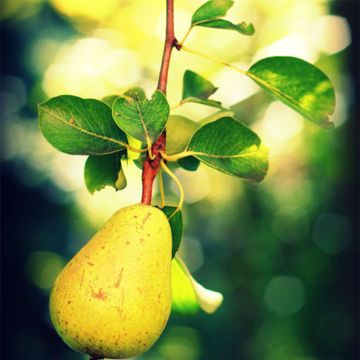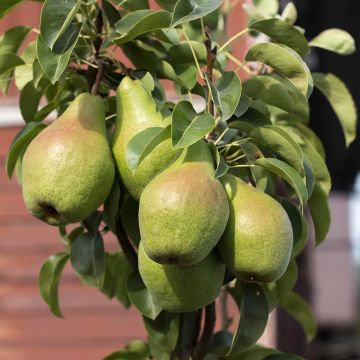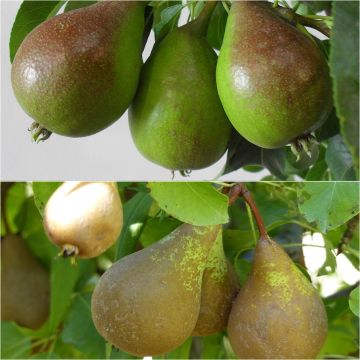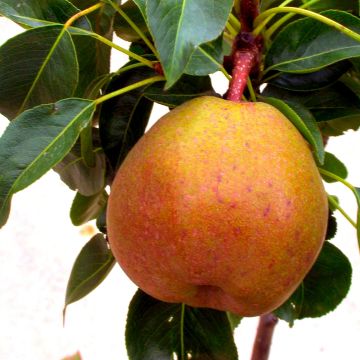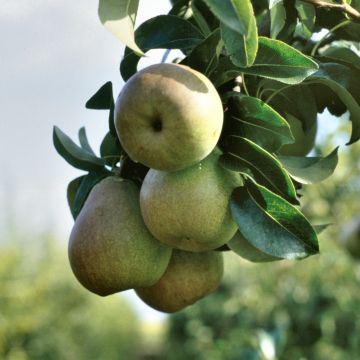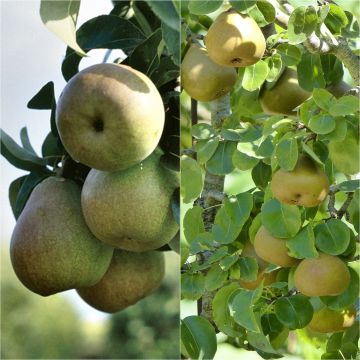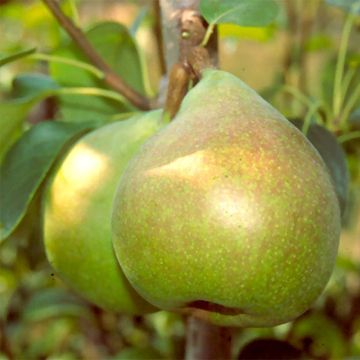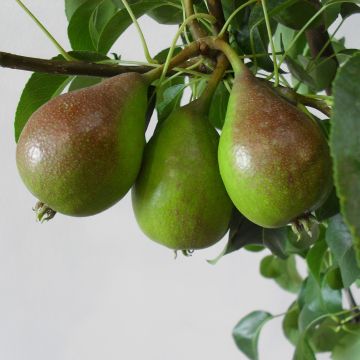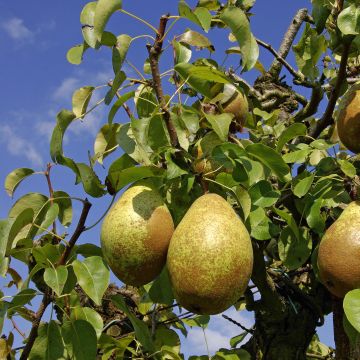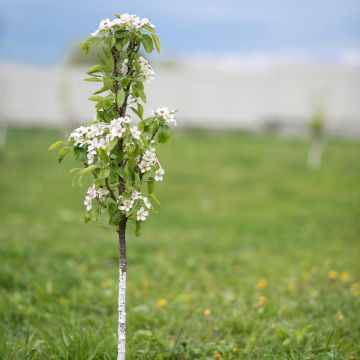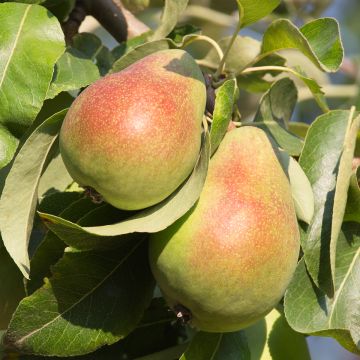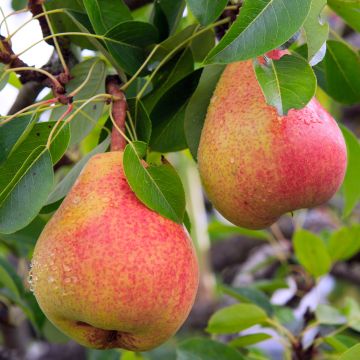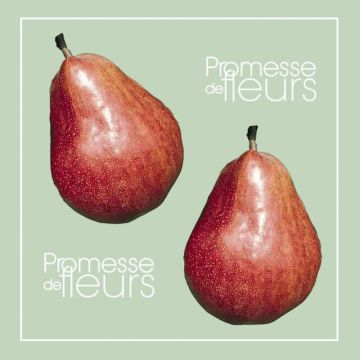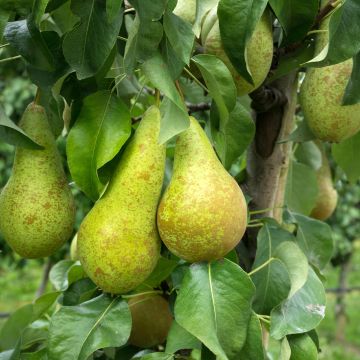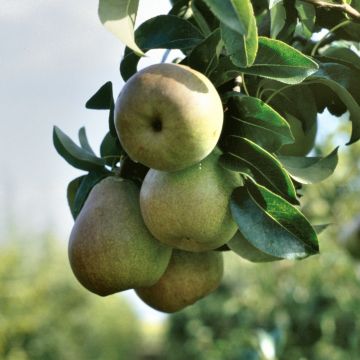

Pyrus communis Williams - U Shape Pear Tree
Pyrus communis William's
Common Pear, European Pear
A beautiful branch was broken upon receipt but has recovered nicely since mid-March.
Geraldine K., 03/04/2023
Why not try an alternative variety in stock?
View all →This plant carries a 6 months recovery warranty
More information
We guarantee the quality of our plants for a full growing cycle, and will replace at our expense any plant that fails to recover under normal climatic and planting conditions.
Oversize package: home delivery by special carrier from €6.90 per order..
Express home delivery from €8.90.
Delivery to Corse prohibited: UE law prohibits the import of this plant from mainland France to Corse as part of the fight against Xylella fastidiosa. Please accept our sincere apologies.
More information



Description
The Williams Pear, or Williams Bon Chrétien, is the most widely grown pear in the world due to its ease of cultivation. Its fruits, ripening to a yellow colour, offer a fine, melting, sweet, and fragrant flesh. Fairly large, with a diameter of about 7 cm (3in), they can be harvested as early as August and can be stored perfectly until November either in a well-ventilated cellar or in the refrigerator. This variety is a very good pollinator for most other pear trees. Its fruiting will be better accompanied by a 'Conference' or 'Guyot' pear tree.
The pear tree is native to central Asia, cultivated in China for 6,000 years. It was introduced to Europe around the 6th century. The Williams Pear, or Bon Chrétien Williams, or also called Bartlett in the USA, originated in the United Kingdom (1796). It is the work of an English schoolteacher, Stair Wheeler, from a natural seedling in his garden. It would then take until the beginning of the 19th century for this variety to spread thanks to a nurseryman named Williams from Turnham.
The Williams Pear will appreciate protected and sunny locations; avoid frost-prone and windy situations. Easy to grow, it likes moist and deep soils, but it dislikes excessively draining and alkaline soils. In winter, give it a shovelful of wood ash, rich in potash, which will improve flowering and fruit quality.
Its semi-erect habit gives it a very elegant pyramidal silhouette, and it is practical for harvesting. Its leaves have an oval lamina, finely toothed on the edge, with a petiole as long as the lamina and measuring about 8 to 9 cm (3 to 4in).
Its flowering is late, starting in early April, protecting it from frosts. Its flowers are formed by 5 white-pink petals. While they are partially self-fertile, it is strongly recommended to plant another pear tree nearby. Indeed, the pear tree is more inclined to cross-pollination. Its most commonly used pollinators are the varieties Doyenné du Comice, Conference, Packams, Guyot, Giffard, General Leclerc, Angelys cov, and Alexandrine Douillard. However, it is not compatible with Louise Bonne and Williams Rouge. Being entomophilous, pollination is mainly ensured by bees.
This variety is known for its yellow fruits at ripeness, offering a fine, melting, sweet, and fragrant flesh, delicious to bite into. It provides a very good yield. Maturity occurs early, in the month of August.
Pears can be consumed fresh, in syrup, in pastries, in jams and compotes, and can be used to make alcoholic beverages.
Report an error about the product description
Plant habit
Fruit
Flowering
Foliage
Botanical data
Pyrus
communis
William's
Rosaceae
Common Pear, European Pear
Cultivar or hybrid
Other Pear trees
Planting and care
Plant the Williams Pear Tree in a sunny location, in acidic or neutral soil, moist but not excessively so. Ensure proper drainage of the planting hole with a thin layer of gravel. Dig a hole two to three times wider and deeper than the pot. On the day of planting, place the tree with its pot in a basin of water, so that the entire root ball is moistened by capillary action. Add compost to the bottom of the hole. Place the tree in the hole and fill with a mixture of soil and compost. Do not bury the graft point. Firmly tamp down the soil around the base. The root ball should be completely covered. Water generously.
In winter, you can add a small handful of wood ash, rich in potash, to improve fruiting.
Planting period
Intended location
Care
-
, onOrder confirmed
Reply from on Promesse de fleurs
Espalier trees
Haven't found what you were looking for?
Hardiness is the lowest winter temperature a plant can endure without suffering serious damage or even dying. However, hardiness is affected by location (a sheltered area, such as a patio), protection (winter cover) and soil type (hardiness is improved by well-drained soil).

Photo Sharing Terms & Conditions
In order to encourage gardeners to interact and share their experiences, Promesse de fleurs offers various media enabling content to be uploaded onto its Site - in particular via the ‘Photo sharing’ module.
The User agrees to refrain from:
- Posting any content that is illegal, prejudicial, insulting, racist, inciteful to hatred, revisionist, contrary to public decency, that infringes on privacy or on the privacy rights of third parties, in particular the publicity rights of persons and goods, intellectual property rights, or the right to privacy.
- Submitting content on behalf of a third party;
- Impersonate the identity of a third party and/or publish any personal information about a third party;
In general, the User undertakes to refrain from any unethical behaviour.
All Content (in particular text, comments, files, images, photos, videos, creative works, etc.), which may be subject to property or intellectual property rights, image or other private rights, shall remain the property of the User, subject to the limited rights granted by the terms of the licence granted by Promesse de fleurs as stated below. Users are at liberty to publish or not to publish such Content on the Site, notably via the ‘Photo Sharing’ facility, and accept that this Content shall be made public and freely accessible, notably on the Internet.
Users further acknowledge, undertake to have ,and guarantee that they hold all necessary rights and permissions to publish such material on the Site, in particular with regard to the legislation in force pertaining to any privacy, property, intellectual property, image, or contractual rights, or rights of any other nature. By publishing such Content on the Site, Users acknowledge accepting full liability as publishers of the Content within the meaning of the law, and grant Promesse de fleurs, free of charge, an inclusive, worldwide licence for the said Content for the entire duration of its publication, including all reproduction, representation, up/downloading, displaying, performing, transmission, and storage rights.
Users also grant permission for their name to be linked to the Content and accept that this link may not always be made available.
By engaging in posting material, Users consent to their Content becoming automatically accessible on the Internet, in particular on other sites and/or blogs and/or web pages of the Promesse de fleurs site, including in particular social pages and the Promesse de fleurs catalogue.
Users may secure the removal of entrusted content free of charge by issuing a simple request via our contact form.
The flowering period indicated on our website applies to countries and regions located in USDA zone 8 (France, the United Kingdom, Ireland, the Netherlands, etc.)
It will vary according to where you live:
- In zones 9 to 10 (Italy, Spain, Greece, etc.), flowering will occur about 2 to 4 weeks earlier.
- In zones 6 to 7 (Germany, Poland, Slovenia, and lower mountainous regions), flowering will be delayed by 2 to 3 weeks.
- In zone 5 (Central Europe, Scandinavia), blooming will be delayed by 3 to 5 weeks.
In temperate climates, pruning of spring-flowering shrubs (forsythia, spireas, etc.) should be done just after flowering.
Pruning of summer-flowering shrubs (Indian Lilac, Perovskia, etc.) can be done in winter or spring.
In cold regions as well as with frost-sensitive plants, avoid pruning too early when severe frosts may still occur.
The planting period indicated on our website applies to countries and regions located in USDA zone 8 (France, United Kingdom, Ireland, Netherlands).
It will vary according to where you live:
- In Mediterranean zones (Marseille, Madrid, Milan, etc.), autumn and winter are the best planting periods.
- In continental zones (Strasbourg, Munich, Vienna, etc.), delay planting by 2 to 3 weeks in spring and bring it forward by 2 to 4 weeks in autumn.
- In mountainous regions (the Alps, Pyrenees, Carpathians, etc.), it is best to plant in late spring (May-June) or late summer (August-September).
The harvesting period indicated on our website applies to countries and regions in USDA zone 8 (France, England, Ireland, the Netherlands).
In colder areas (Scandinavia, Poland, Austria...) fruit and vegetable harvests are likely to be delayed by 3-4 weeks.
In warmer areas (Italy, Spain, Greece, etc.), harvesting will probably take place earlier, depending on weather conditions.
The sowing periods indicated on our website apply to countries and regions within USDA Zone 8 (France, UK, Ireland, Netherlands).
In colder areas (Scandinavia, Poland, Austria...), delay any outdoor sowing by 3-4 weeks, or sow under glass.
In warmer climes (Italy, Spain, Greece, etc.), bring outdoor sowing forward by a few weeks.


































